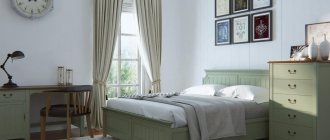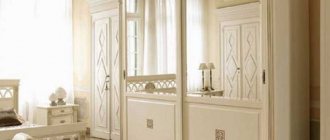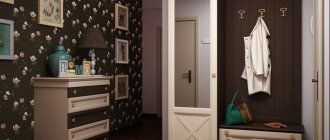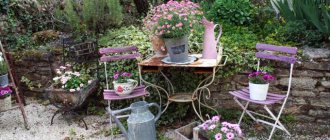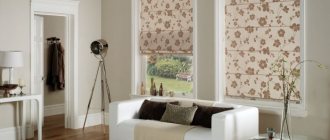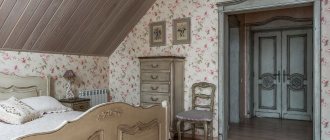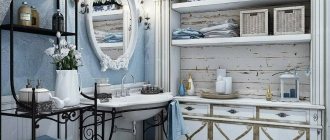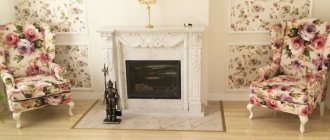Provence style and its history
A style called “Provence” appeared in France in the 19th century. It was named after one of the regions of this country. The capital of the style was the city of Marseille.
The prerequisites for Provence appeared in the mid-17th century. People wanted to get closer to the village from the boring bustle of the city. Entire families of industrialists and lawyers begin to furnish their own homes in a style reminiscent of this style.
The Provence style, widespread throughout the world, has French roots.
The main features of the style were:
- game of sunny colors,
- natural lightness,
- naturalness,
- open space.
Stylistic decisions
For the Provence style, experts recommend the following solutions:
- Solid floor . The classic version assumes the presence of wooden or stone floors. Using special floor tiles you can easily achieve this effect.
- Walls . Wallpaper in the generally known sense does not exist in this style. In this case, brickwork or carelessly applied plaster are most suitable for this design.
- Furniture should ideally create a feeling of antiquity. Make it with your own hands so that guests have the impression that it has been passed down to each other for many generations.
- Details. Any, even the smallest details must be carefully thought out and planned. In this style, even the most ordinary napkin can carry a certain semantic meaning.
Secrets of Provence style (video)
Ready-made examples of aging different furniture with your own hands
The chest of drawers “aged” using the reverse patination method looks good. In this case, abrasions are achieved not by rubbing off the patina, but by rubbing away the underlying layer of paint.
An old Soviet cabinet restored in Provence style with an attached additional storage system in the form of a bookcase.
If the work is done correctly and in compliance with the appropriate instructions, furniture made in this style will give the room a feeling of comfort and coziness.
Rack and shelf, aged with patina.
Provence creates a lovely homely coziness and a comfortable indoor environment.
In addition to aging furniture, the Provence style can always be complemented by decoration using decoupage techniques and other types of painting. Antique trinkets, handmade souvenirs, and fresh flowers will look great in this interior.
Any antique item can be restored, repainted and given a decorative role in the Provence style.
Several ways to age furniture surfaces
Artificially aged furniture looks as excellent as truly antique furniture. However, it is much easier, faster and cheaper to do.
Of the ways in which you can age furniture yourself at home, there are three main ones:
- Mechanical . Thanks to this method, artificial scratches, cracks and other damage appear on furniture.
- Chemical . In this embodiment, substances such as craquelure varnishes, ammonia, stain and much more are used.
- Thermal . Using an open fire or a soldering iron, an antique effect is achieved.
Necessary tools and materials for making furniture in Provence style
For professional furniture restoration you will need:
- acrylic paint,
- matte polyurethane glaze,
- oil and water based varnish,
- gold effect paint,
- sandpaper,
- necessary stencils.
Decoupage is an integral part of creating the Provence style with your own hands
Artificially aged furniture surfaces are a clear sign of Provence style
Modern kitchens in the Provence style cannot necessarily be made in cream or white
Do-it-yourself stages
All work happens this way:
- All fittings are dismantled and cleaned of old paint and varnish.
- Acrylic paint is applied to the surface.
- Using a stencil, you make a drawing with your own hands, which must be left alone until completely dry.
- Oil varnish is applied to the surface and left for several hours.
- After this, the product is coated with a layer of water-based varnish.
- Using a hair dryer, the effect of a specific flowing pattern is created. The product is left in this position for 3 hours.
- Using a hard small brush, apply the remaining varnish to the product.
Using eggshells and craquelure varnish, an artificially aged surface is created
The main touches that give the surface individuality are best applied without a stencil.
Upholstered furniture and its upholstery
Using a furniture stapler, you can thoroughly transform upholstered furniture. First of all, you need to choose a fabric.
It must be:
- soft,
- having a pattern with natural elements or geometric shapes,
- no flashy colors.
Finding such fabric is not difficult. All you have to do is climb into your grandmother's chest or attic.
In addition to the method described above, there is another way to give the furniture an antique effect. An interesting technique that uses two-component crackle varnish will help in this matter. It is applied in several layers. Using a brush with natural bristles, apply the layers in an even, thin layer. The varnish dries in 40 minutes.
The second layer is applied in the same way. The more cracks you want, the thicker the layer itself should be. To make the surface dry faster, you can dry it with a hairdryer. When the varnish dries, all resulting cracks are rubbed with dark oil paint, gold powder or bitumen. To consolidate the effect, another layer is applied with colorless varnish.
Upholstery of upholstered furniture in the kitchen can be combined with wall decoration in the same style
History and characteristics of Provence
The Provence style direction was formed in one of the provinces of France, from which it got its name. It is believed that Provence as a style was formed in the 19th century, although the first prerequisites for its emergence began to appear 200 years earlier - at a time when cities were actively developing in France.
Despite the simplicity of the solutions and “rustic” origin, Provence was considered an elite style
Even then, some people were tired of the endless bustle of cities, and they sought, if not to change their place of residence, moving closer to nature, then at least to give their apartments and estates a rural charm. Despite the simplicity of the solutions and “rustic” origin, Provence was considered an elite style. This is the solution that families of lawyers and large industrialists preferred to decorate the rooms of.
The main elements of Provence were:
- openness;
- use only natural materials;
- light, “sunny” colors;
- ease.
Provence is characterized by certain details that allow you to create the right mood in the room. First of all, a massive floor, which will only emphasize the lightness of decorative elements and furniture. To create a similar effect, wood or stone is traditionally used as flooring, but it is acceptable to use tiles that imitate natural materials.
Furniture should look like antique
The walls in the premises are not covered with wallpaper. Instead, ordinary brick or stone masonry, carelessly painted or plastered, is used.
The main focus in Provence is on furniture. First of all, it must be old. However, a new one will do, if you first aging the furniture in the Provence style with your own hands. In any case, the furniture should look like antique.
As for decorative items, they need to be selected very carefully and their placement carefully thought through so as not to “overdo it.” Sometimes one simple napkin is enough to give a certain mood.
DIY chest of drawers and its decoupage
Provence style furniture is made from:
- wood,
- gland,
- vines
Designers categorically do not recommend using materials such as chipboard, MDF and PVC.
If you still have your grandmother's chest of drawers, then you can make it as good as new and even better. It’s enough to do some easy decoupage with your own hands.
The manufacturing instructions are as follows:
- First you need to paint the chest of drawers in light colors.
- Wait for the paint to dry completely.
- Using sandpaper, chips and simple abrasions are made on the surface.
- The top of the chest of drawers is covered with wax.
- When the paint is completely dry, the chest of drawers is upholstered in soft fabric depicting natural patterns.
- It is also important to use forged elements. The chest of drawers will look much better if it has forged arms or legs.
You can create a unique design of any furniture with your own hands
Provence style does not have to include scuffs
In general, a chest of drawers is not the only piece of furniture to which decoupage can be applied. The main thing is to use materials and colors correctly to achieve coziness and comfort in any room.
Of course, you can buy a new high-quality chest of drawers at a hardware store. But many people are faced with the fact that this piece of furniture is expensive and many simply cannot afford it. That’s why decoupage in Provence style is simply an amazing solution to this problem.
Step-by-step master class on aging furniture
- Applying a base coat of paint.
- Drying. You can use a hair dryer to speed up the process.
- Treatment of aging areas with paraffin.
- Adding putty for relief and creating the effect of a multi-layer coating.
- Creating a worn effect. This is achieved by friction with sandpaper, a stiff brush or iron wool... or by applying paint with a sponge, then the previous layer will be perceived as abrasion.
- Painting in several layers.
- Sanding.
- Patination.
- Drying.
After complete drying, you can begin sanding the area to be treated, then begin decorating.
If you have decorating skills, you can additionally paint furniture in the Provence style with your own hands. Floral ornaments and images with rural motifs will look especially organic.
You can use decoupage napkins with designs in the Provence style, which are transferred to furniture.


